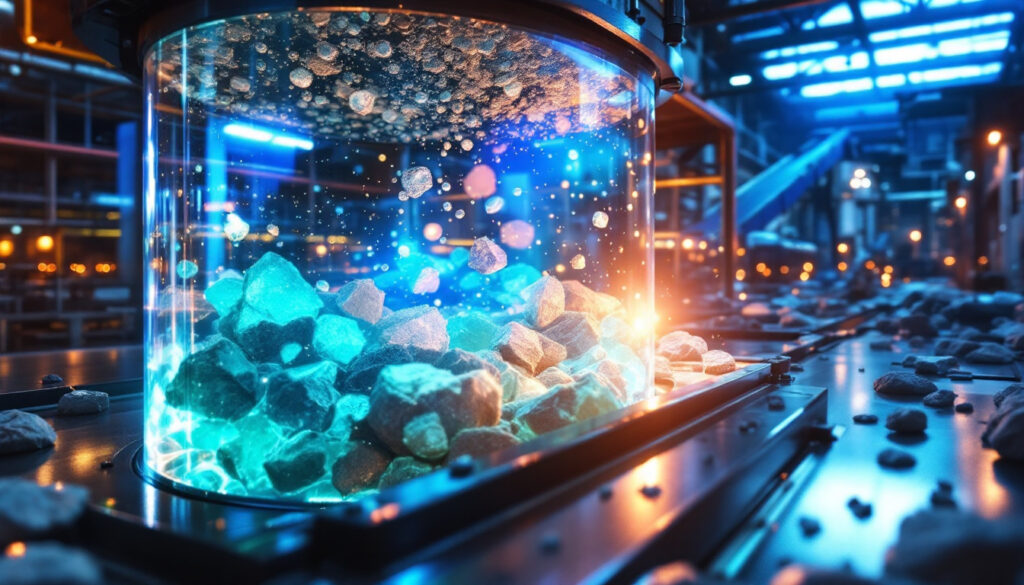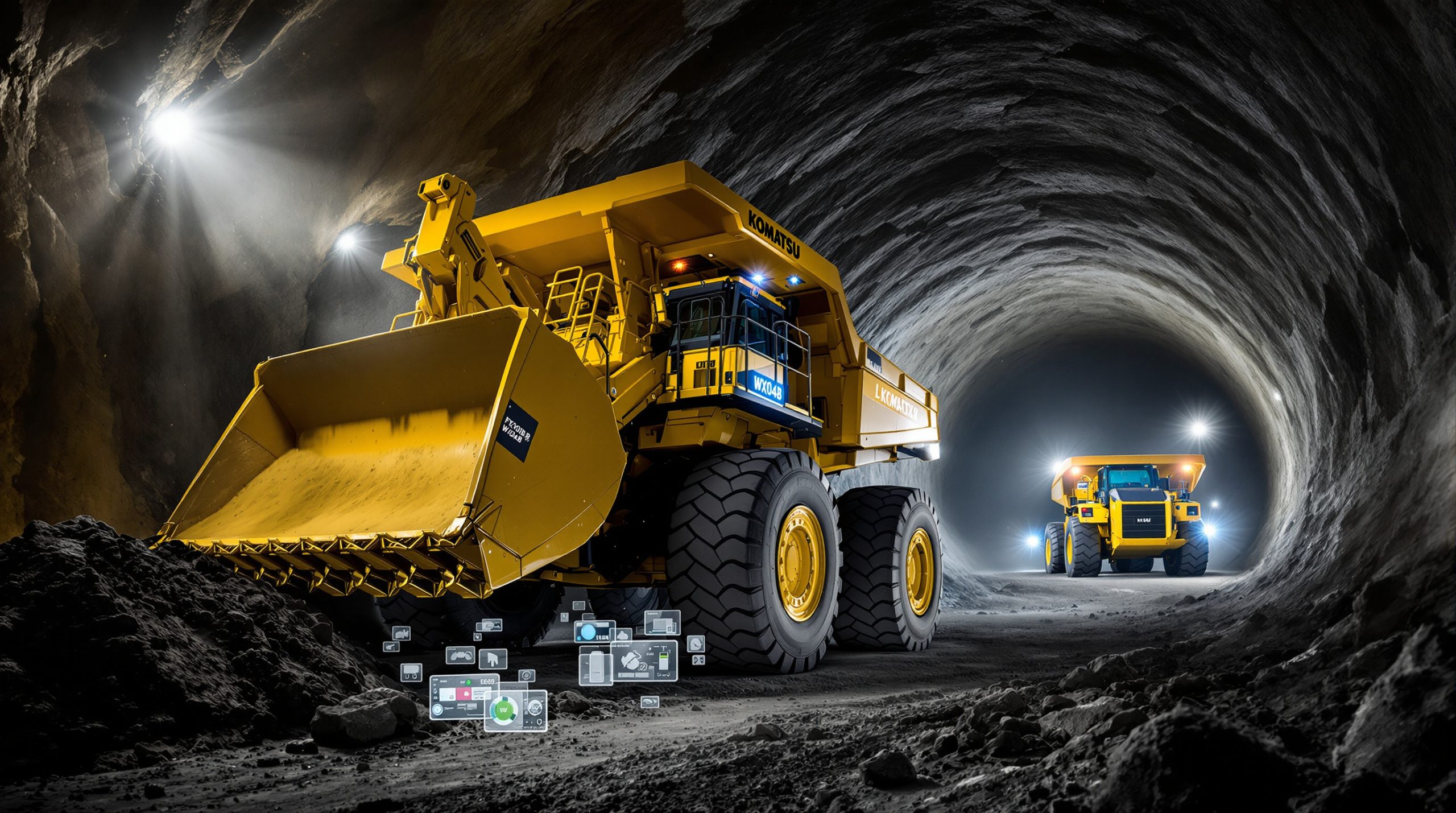What is Eriez HydroFloat Technology and How Does It Revolutionize Mining?
Mineral processing operations worldwide are experiencing a transformative shift thanks to the introduction of Eriez HydroFloat technology. This revolutionary coarse particle flotation system has been installed in more than 70 mining operations across six continents, representing a paradigm shift in how mineral recovery is approached.
Unlike conventional flotation cells that have dominated the industry for decades, the HydroFloat technology enables the recovery of particles up to 400-500 microns in size—more than double the size limitations of traditional methods. This capability alone has opened new possibilities for mineral processors seeking to optimize recovery while reducing energy and water consumption.
The technology has demonstrated remarkable versatility across different mineral applications, including copper, gold, iron ore, phosphate, and increasingly, critical minerals essential for renewable energy technologies. By fundamentally altering the particle-bubble interaction dynamics, the HydroFloat addresses longstanding inefficiencies in mineral processing circuits.
"The HydroFloat's fluidized-bed design fundamentally redefines coarse particle flotation, addressing a century-old industry challenge," notes the Eriez Engineering Team. This innovation represents not merely an incremental improvement but a step-change in flotation technology capabilities.
How Does Coarse Particle Flotation Technology Work?
Understanding the Fluidized-Bed Design Advantage
At the heart of HydroFloat technology lies its revolutionary fluidized-bed design. Unlike conventional flotation cells where turbulence often prevents effective bubble-particle attachment for larger particles, the HydroFloat creates ideal conditions for coarse particle flotation.
The system operates by maintaining mineral particles in suspension through a carefully controlled upward flow of water. This fluidization creates a teeter bed where particles remain in constant, gentle motion. Simultaneously, air bubbles introduced through specialized aerators rise through this bed, maximizing contact opportunities with mineral surfaces.
This approach eliminates the "dead zones" common in conventional cells where coarse particles settle out of the active flotation zone. "The fluidized-bed design eliminates 'dead zones,' ensuring consistent particle interaction," explains Dr. Maria Chavez, a mineral processing expert who has studied the technology's implementation across multiple sites.
The combination of controlled fluidization and optimized aeration creates conditions where even minimally liberated particles with small exposed mineral surfaces can successfully attach to bubbles and float—something virtually impossible in conventional cells.
Breaking Through Traditional Size Limitations
For decades, the mineral processing industry has operated under the constraint that flotation becomes increasingly inefficient as particle size increases beyond 150-200 microns. This limitation has forced operations to invest heavily in energy-intensive grinding to reduce particle size, regardless of whether such fine grinding was metallurgically necessary.
The HydroFloat technology shatters this paradigm by effectively recovering particles up to 400-500 microns—more than twice the conventional upper limit. This capability transforms processing strategies by enabling operations to target coarser grind sizes while maintaining or even improving recovery.
Technical testing has demonstrated that the technology can achieve up to 90% recovery of particles as large as 425 microns for copper sulfides with just 10% exposed mineral surface. Conventional cells typically achieve less than 20% recovery at these specifications.
The ability to recover coarser particles translates directly into reduced grinding requirements, which addresses one of the most energy-intensive and expensive aspects of mineral processing. Ball mill energy consumption can be reduced by 30-50% through coarse gangue rejection applications.
What Are the Key Applications of HydroFloat Technology?
Tailings Scavenger Application: Recovering Lost Value
The tailings scavenger (TS) application represents a significant opportunity for existing operations to enhance recovery without major circuit modifications. By installing HydroFloat technology at the end of conventional flotation circuits, operations can recover valuable minerals that would otherwise be lost to tailings.
In copper operations specifically, tailings scavenger applications have demonstrated global recovery increases of 2-6%. While this percentage may seem modest, it translates into substantial value over a mine's life. A medium-sized copper operation producing 100,000 tonnes of copper annually could recover an additional 2,000-6,000 tonnes of copper—worth $15-45 million at current prices—simply by capturing what was previously discarded.
"CGR lets us bypass grinding 40% of our feed, slashing costs," notes a Plant Manager at BHP Olympic Dam, highlighting the significant operational benefits. The tailings scavenger approach allows operations to maintain or even coarsen their primary grind size while improving overall recovery, creating opportunities for increased throughput without additional grinding capacity.
Implementation in existing operations typically requires minimal disruption to ongoing production, with installations possible during planned maintenance periods. The compact footprint relative to conventional cells makes retrofit installations particularly attractive.
Coarse Gangue Rejection: Transforming Processing Efficiency
The coarse gangue rejection (CGR) application represents an even more fundamental shift in processing strategy. By implementing HydroFloat technology early in the circuit, operations can identify and reject 30-40% of non-valuable material (gangue) before it enters energy-intensive grinding circuits.
This approach directly addresses the inefficiency of grinding material that contains no recoverable minerals. By removing siliceous gangue early, operations dramatically reduce the volume of material requiring fine grinding—the most energy-intensive and expensive processing step.
A Chilean concentrator reduced grinding costs by $2 million annually by implementing CGR, demonstrating the significant financial impact possible. Beyond cost savings, CGR applications also unlock significant throughput increases by reducing the load on downstream grinding and flotation circuits.
The environmental benefits are equally compelling, with water and energy consumption reduced proportionally to the amount of rejected gangue. This approach aligns perfectly with the industry's increasing focus on decarbonisation in mining.
What Benefits Does the HydroFloat Technology Deliver?
How Does HydroFloat Increase Operational Profitability?
The financial benefits of HydroFloat technology flow through multiple pathways, creating compelling returns on investment for adopters. These economic advantages include:
- Increased plant throughput: Operations have reported throughput increases of up to 35% through the combination of coarser grinding and reduced processing bottlenecks.
- Recovery improvements: Global recovery increases of 2-6% for copper and similar improvements for other valuable minerals directly boost revenue.
- Energy cost reduction: Ball mill energy consumption reductions of 30-50% significantly lower operating costs, particularly important as energy prices rise.
- Water savings: Improved water efficiency reduces both environmental impact and operating costs, particularly in water-scarce regions.
- Maintenance savings: The simplified design with no moving parts reduces maintenance requirements by approximately 50% compared to conventional cells.
"Payback periods under 12 months make HydroFloat a no-brainer," notes a Financial Analyst at Rio Tinto who has evaluated multiple implementations. This rapid return on investment has driven increasing adoption rates across the industry, particularly as operations face pressure to improve efficiency and reduce costs.
A Brazilian iron ore site reported $15 million in annual savings from reduced grinding alone, demonstrating the scale of potential benefits for larger operations. Even smaller sites typically see significant financial improvements, with ROI often achieved within the first year of operation.
What Environmental Sustainability Advantages Does It Offer?
The environmental benefits of HydroFloat technology align directly with the mining industry's growing focus on sustainability and reduced environmental footprint:
- Energy consumption reduction: Overall energy use typically decreases by up to 20% across processing operations, with proportional reductions in carbon emissions.
- Water efficiency: The technology operates at 85% water recovery efficiency, crucial for operations in arid regions facing water scarcity challenges.
- Carbon footprint reduction: Lower energy requirements directly translate to reduced greenhouse gas emissions, supporting corporate climate commitments.
- Tailings volume reduction: CGR applications can reduce tailings volume by 30-40%, addressing one of mining's most significant environmental challenges.
- Chemical reagent reduction: More efficient processing typically requires fewer flotation reagents per tonne of concentrate produced.
South African platinum operations implemented HydroFloat technology specifically to address water scarcity concerns, achieving a 25% reduction in water usage while maintaining production targets. This case demonstrates how the technology can directly address region-specific environmental challenges.
The reduced tailings volume and improved characteristics also contribute to safer, more sustainable tailings storage—an increasingly important consideration following high-profile tailings dam failures in recent years.
How Does the Design Enhance Operational Efficiency?
The HydroFloat's engineering provides several distinct operational advantages that contribute to its effectiveness:
- Maintenance-friendly design: With no moving parts within the separation zone, maintenance requirements are dramatically reduced compared to mechanical flotation cells.
- Precise metallurgical control: The proprietary fluidization system allows fine-tuning of separation parameters to optimize performance for specific ore characteristics.
- Compact footprint: The HydroFloat typically requires 30-50% less floor space than conventional flotation circuits with equivalent capacity.
- Scalability: Modular design principles enable applications from pilot scale (50 TPD) to large industrial installations (5,000+ TPD).
- Operational flexibility: The system can be quickly adjusted to accommodate changes in feed characteristics or processing objectives.
The technology's integration with IoT-enabled control systems allows real-time adjustments based on ore characteristics and performance metrics. This advanced control capability ensures consistent performance even with variable feed properties—a common challenge in mining operations.
Where Has HydroFloat Technology Been Successfully Implemented?
Global Adoption Across Diverse Mining Operations
HydroFloat technology has been installed in more than 70 mining operations worldwide, spanning six continents and numerous mineral applications. This broad implementation demonstrates both the technology's versatility and its proven performance across diverse operating conditions.
The global distribution includes:
- 15+ installations in copper operations, primarily in Chile, Peru, and Australia
- 10+ implementations in gold mining, across North America, Australia, and Africa
- 8 installations in lithium operations, supporting the growing battery materials sector
- Multiple applications in iron ore, phosphate, and polymetallic operations
"HydroFloat transformed our tailings management strategy," reports the COO of Newmont Goldcorp, highlighting how the technology addresses multiple operational challenges simultaneously. Each implementation has been tailored to specific site conditions, ore characteristics, and operational objectives.
The Pilbara iron ore region in Australia has been particularly receptive to the technology, with multiple installations reporting yield increases averaging 12% through CGR applications. These implementations have been driven by the region's focus on operational efficiency and water conservation.
Performance Across Different Mineral Applications
The HydroFloat system has demonstrated remarkable versatility across different mineral types, with performance tailored to specific metallurgical challenges:
- Copper operations: Recovery improvements of 2-6% are typical, with particularly strong results for porphyry copper deposits with coarse dissemination.
- Gold mines: Similar recovery gains are achieved, especially for operations with free gold losses in coarser fractions.
- Iron ore processing: Grade and recovery improvements of 3-5% have been documented, enhancing product value.
- Phosphate operations: Energy consumption reductions of up to 40% while maintaining or improving recovery.
- Lithium processing: Recovery improvements for spodumene concentrate from hard rock sources.
- Polymetallic operations: Enhanced separation efficiency across multiple minerals of interest.
A Nevada gold mine reported not only improved recovery but also reduced cyanide consumption due to higher-grade concentrate produced through more selective separation. This highlights how the technology's benefits often extend beyond the primary recovery metrics.
The technology's adaptability to different mineral systems stems from its customizable aeration and fluidization parameters, which can be optimized for specific ore characteristics. This flexibility makes the HydroFloat applicable to most flotation-based mineral processing operations regardless of the target mineral.
What Recognition Has the Technology Received?
Industry Awards and Technical Validation
The innovative nature of HydroFloat technology has been recognized through multiple industry awards, most notably the 2025 Murray Award for Innovation from the Society for Mining, Metallurgy & Exploration (SME). This prestigious recognition highlights the technology's transformative impact on mineral processing practices.
The Murray Award specifically acknowledges innovations that drive significant improvements in processing efficiency and sustainability—both core outcomes of HydroFloat implementation. The award committee noted the technology's "paradigm-shifting approach to coarse particle recovery" in their citation.
Beyond formal awards, the technology has been validated through extensive peer-reviewed technical publications in journals such as Minerals Engineering and International Journal of Mineral Processing. These publications document performance improvements across various applications and provide third-party verification of the technology's capabilities.
Case studies presented at major conferences, including the SME Annual Conference and Expo and the International Mineral Processing Congress, have further contributed to industry-wide recognition of the technology's effectiveness. These presentations typically include detailed performance data and comparative analyses with conventional technologies.
How Does HydroFloat Compare to Conventional Flotation Technologies?
Key Performance Differentiators
When compared to traditional flotation cells, the HydroFloat technology offers several distinct advantages that collectively transform mineral processing capabilities:
| Parameter | Conventional Flotation | HydroFloat Technology | Key Advantage |
|---|---|---|---|
| Maximum Particle Size | 150-200 microns | 400-500 microns | 2-3x larger particles recovered |
| Energy Consumption | Base reference | 30-50% reduction | Lower operating costs |
| Water Requirements | Base reference | 15-25% reduction | Sustainability in water-scarce regions |
| Footprint | Base reference | 30-50% smaller | Easier installation in constrained spaces |
| Maintenance | Regular (moving parts) | Minimal (no moving parts) | Higher availability, lower maintenance costs |
| Capital Cost per Capacity | Base reference | 15-25% lower | Better return on investment |
These differentiators address many of the limitations that have constrained conventional flotation technology for decades. The ability to recover significantly coarser particles fundamentally changes grinding requirements, while the fluidized-bed design eliminates the turbulence issues that limit conventional cells' effectiveness with larger particles.
The energy efficiency advantages are particularly significant as mining operations face increasing pressure to reduce carbon emissions and energy costs. The reduced water requirements similarly address growing concerns about water scarcity in many mining regions.
Integration with Existing Processing Circuits
The HydroFloat system is designed for seamless integration with existing mineral processing operations, enabling phased implementation that minimizes disruption to ongoing production. This integration typically follows a structured approach:
- Circuit analysis: Detailed evaluation of the existing circuit identifies optimal application points for either tailings scavenger or coarse gangue rejection implementation.
- Pilot testing: On-site pilot trials using representative ore samples validate performance expectations and optimize operating parameters.
- Phased implementation: Installation often occurs during planned maintenance periods, with minimal production disruption.
- Integration with control systems: The technology connects with existing distributed control systems for centralized monitoring and control.
- Performance optimization: Post-installation fine-tuning maximizes performance for specific ore characteristics.
This flexibility allows operations to adopt the technology without major circuit redesigns or extended downtime. The modular nature of HydroFloat installations means they can be expanded incrementally as operations validate performance and justify additional capacity.
What Future Developments Are Expected for Coarse Particle Flotation?
Emerging Applications and Technology Enhancements
The coarse particle flotation field continues to evolve rapidly, with several emerging trends that suggest expanded capabilities and applications:
- Integration with advanced sensing and control systems: Machine learning algorithms are being developed to optimize HydroFloat performance based on real-time ore characterization.
- Application to increasingly complex and low-grade ores: Ongoing research focuses on extending the technology's capabilities to challenging ore types that resist conventional processing.
- Combination with other innovative separation technologies: Hybrid circuits combining HydroFloat with technologies like sensor-based sorting show promising synergies.
- Further optimization for water-scarce environments: Next-generation designs aim to further reduce water consumption, particularly important in arid mining regions.
- Adaptation for critical minerals processing: Growing demand for battery materials and rare earth elements is driving application development for these challenging ore types.
These developments suggest the technology will continue to expand its capabilities and applications in coming years, potentially extending the size range even further and addressing additional mineral systems.
Research partnerships with major universities and mining companies are accelerating these developments, with particular focus on critical minerals essential for renewable energy technologies. This alignment with the energy transition has attracted significant research funding and industry attention.
FAQs About Eriez HydroFloat Technology
What particle size range is optimal for HydroFloat operation?
The technology operates effectively with particles ranging from 100 to 500 microns, with the most significant advantages realized in the 200-400 micron range where conventional flotation efficiency typically declines dramatically. The precise optimal size range varies by mineral type and liberation characteristics, with sulfide minerals typically showing effective recovery at larger sizes than oxide minerals.
Pilot testing typically determines the ideal size distribution for specific ore bodies, allowing operations to target the appropriate grind size to maximize the technology's benefits. This size range optimization is a critical step in implementation planning.
How does the system handle variations in ore characteristics?
The HydroFloat incorporates adjustable fluidization and aeration systems that can be tuned to accommodate variations in ore density, mineralogy, and liberation characteristics. This adaptability enables consistent performance across changing feed conditions—a common challenge in mining operations.
Key adjustment parameters include:
- Fluidization water rate, which controls bed expansion and particle suspension
- Aeration rate and bubble size, optimized for specific mineral characteristics
- Bed level and froth depth, adjusted based on liberation and recovery objectives
- Reagent
Ready to Catch the Next Big Mining Discovery?
Discover significant ASX mineral announcements before the market with Discovery Alert's proprietary Discovery IQ model, delivering real-time insights on high-potential opportunities. Explore why major mineral discoveries can generate exceptional returns by visiting our dedicated discoveries page and begin your 30-day free trial today.




